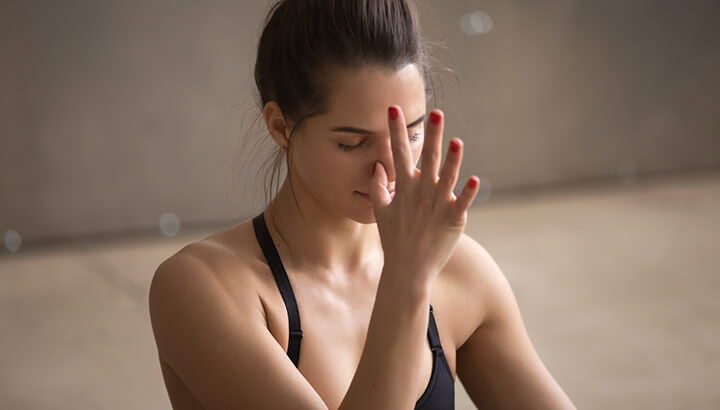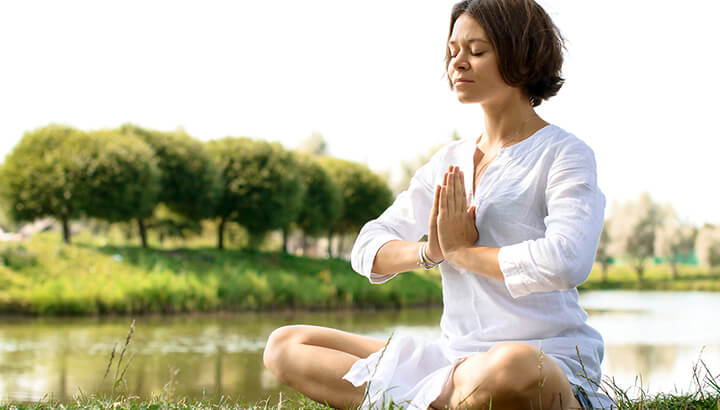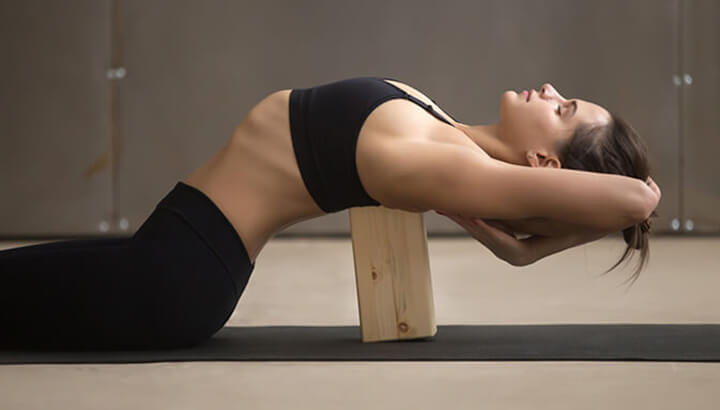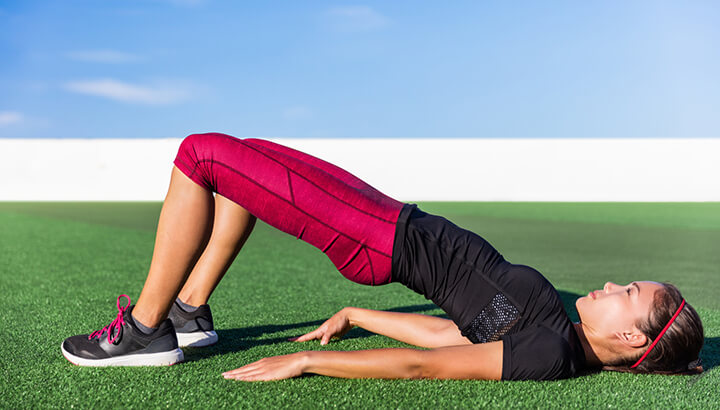If you’ve ever experienced a panic attack, you know how disruptive they can be. If you’ve never had one, trust me when I say panic attacks can convince you that you’re going to die right where you stand. My solution? Drop into one (or more) of these yoga poses. Each one can bring you back to center and cut a panic attack off before it takes over.
What is a panic attack?
You can have anxiety without ever experiencing a panic attack, but if you experience anxiety frequently, you might find yourself in the throes of an attack at some point. An attack happens seemingly out of nowhere and hits a peak within mere minutes. According to the Anxiety and Depression Association of America, a panic attack must include at least four of the following symptoms:
- Sweating
- Shaking/trembling
- A pounding heart, palpitations or a racing heartbeat
- Nausea
- The feeling that you’re choking
- Shortness of breath/feeling like you can’t breathe
- Chills
- Heat sensations
- Numbness or tingling
- Feeling dizzy or lightheaded
- Feeling detached from yourself
- Feeling disconnected from reality
- Fear of dying
- Fear of losing control
Panic attacks usually hit their height of intensity in ten minutes or less before symptoms begin to settle down. They can imitate breathing disorders like asthma, heart problems, thyroid issues and other illnesses, so it can be difficult to pin down what’s really going on for people who have never experienced a panic attack.
People who have experienced multiple attacks usually have a toolbox full of solutions when an attack is coming on. Adding a few yoga poses to the mix can help you stop a panic attack in its tracks.
How yoga can help with panic attacks
Yoga is a practice that’s centered on controlling the breath and tuning into the body. Both of these pull your attention into the present moment, which forces you to drop fears about the future and anxiety over the past. There are also many physical components of the practice that settle the nervous system and bring balance back to the body. Together, yoga presents a recipe for stress relief and a reduction in panic attacks.
Five yoga poses to stop a panic attack now:
1. Alternate nostril breathing

Alternate nostril breathing, or nadhi shodhana, uses the breath to bring balance to the brain and the nervous system. This yoga pose is especially beneficial because you can do it just about anywhere and you don’t even have to be in yoga clothes to practice it! Alternate nostril breathing balances the left and right sides of the brain, lowers your heart rate, reduces anxiety and stress and helps energize you when you’re tired.
At the onset of a panic attack, sit down and place the thumb of your right hand on your right nostril. Your index and middle finger should be right in front of your face, centered between your eyebrows. Place your right ring finger over your left nostril, but don’t close that nostril yet.
Close your right nostril with your thumb and inhale slowly through the left nostril. Then, close the left nostril with your ring finger. Pause for a moment before opening your right nostril and exhaling through it. With this nostril still open, draw the breath in, close it with your thumb, pause for a moment and then open to left nostril to exhale.
Inhale again through the left nostril to start the cycle over again. Repeat this pattern five to ten times before resuming your normal breath.
2. Easy pose

It may seem strange to practice easy pose when you’re having a panic attack — it’s easy to practice and doesn’t seem to have much benefit on the surface — but when you’re in the midst of an attack, the last thing you want to do is complicate things. Easy pose is also the perfect pose to sit in when practicing alternate nostril breathing.
To practice this pose, sit on your mat with your legs crossed. If you have lower back pain, sit on the edge of a yoga blanket or use a small cushion to elevate your hips above your knees. Sit up straight and focus on lengthening the spine. As you do, think about relaxing the shoulders and letting them drop from your ears. Close your eyes and bring your attention to your breath. Use this time to slow your breath, if you can, and just sit in the moment.
Easy pose calms both the brain and the body while giving you a good stretch in your legs. It can also teach you how to tune into your body in the present moment, without stressing you out.
3. Fish pose

Fish pose is another fairly easy pose and starts with you lying on your back. Bend your knees and place your feet flat on the mat. Inhale and lift your pelvis a bit off the floor and slide your hands under your buttocks, palms against the mat. Then lower your buttocks down to your hands and keep them there throughout the pose. Tuck your forearms and make sure to keep your elbows close to your body.
On the inhale, press your elbows and forearms against the mat. Lift your upper torso away from the floor in a gentle backbend. Release your head gently back to the mat. Depending on how deep you go in the pose, the back or the crown of your head will be resting against the mat. Be sure not to rest your weight on your head, though, so if there’s too much pressure on your head and neck in the pose, reduce the amount you’re arching your back.
Keep your knees bent or extend your legs and straighten them out in front of you if it feels comfortable. Your thighs should remain active and be sure to press through your heels. Stay in the pose for 15 to 30 seconds before gently releasing and lowering your torso back to the floor.
Fish pose is very beneficial for people who deal with insomnia or experience migraines. It can also help lower your blood pressure and reduce anxiety — a huge benefit when a panic attack is coming on.
4. Cat-cow pose sequence

A cat-cow pose sequence is highly restorative and flowing. Plus, it’s very easy to practice. Begin on all fours in a “tabletop” position with your back straight, your hips over your knees and your shoulders aligned with your wrists. Inhale and arch your back toward your mat, lifting your sit bones and chest up. Look forward to come completely into cow pose.
Then, on the exhale, drop your chest and look toward the floor. Arch your back up toward the ceiling, like the arched back of a cat, to practice cat pose. On the next inhale, move back into cow pose, looking up while you do. Repeat this cycle for five sets of the poses.
Together, these poses help you tune into your breath, so you can consciously slow it down. They also open the chest and back, making it easier to breathe.
5. Bridge pose

Bridge pose is the most complicated pose here but may give you the best benefit. It helps to stretch the neck, chest and spine, opening the area up for deeper, fuller breaths — a great benefit when you feel like you can’t catch your breath. It also reduces anxiety and fatigue and is believed to be therapeutic for high blood pressure and asthma, among other conditions.
To practice bridge pose, lie on your back. Use a folded blanket under your shoulders and neck if you need some support in your upper body. Bend your knees and set your feet on the floor, with your heels as close to your rear as possible. Exhale and, while pressing your inner feet and arms into the mat, raise your tailbone up and lift your rear off the mat. Keep your thighs pressed together and your feet parallel to one another as you move your hands toward one another and clasp them on the mat below your hips.
The key to this pose is to shift back onto the tops of your shoulders gently. Lift your rear more until your thighs are parallel to the mat. Your knees should be aligned with your heels. Lift your chin a bit to make sure you aren’t constricting your airway. Stay in the pose for at least 30 seconds, but up to a minute if you can hold it reasonably comfortably there. Release on the exhale and slowly roll back to the floor when done.
Do you have a favorite pose for panic attacks? Tell us about it in the comments!

